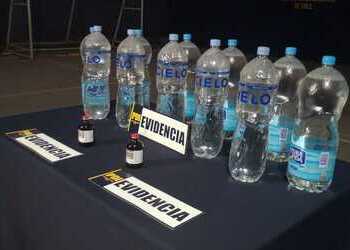Ketamine flows are soaring in Chile as foreign and domestic traffickers increasingly import the hallucinogenic from neighboring countries, revealing the substance’s growing role in Chile’s booming synthetic drug market.
On June 15, Chile’s investigative police announced that its Microtráfico Cero (MT-0) program, focused on interdicting local drug sales, had seized nearly 220 kilograms of ketamine between January and May 2022, a vast year-on-year increase. Ketamine was also seized in larger quantities than any other drug, including marijuana.
SEE ALSO: Chile Struggles to Deal With Colossal Influx of Synthetic Drugs
Some media outlets have cited slightly different figures, perhaps due to inter-agency differences, but there is agreement that this year’s seizures have already far surpassed the record 125 kilograms of ketamine confiscated in 2021, according to Chile’s 2021 Drug Trafficking Observatory report.
Most seizures take place in northern customs points, stated the report. Notable recent interdictions include the April 2022 arrest of a Venezuelan couple carrying 11 kilograms of ketamine in the border region of Tarapacá and in March 2022, when Chilean border officials in the province of Arica seized more than 19 kilograms of ketamine from Venezuelan nationals.
The drug is usually transported in liquid form as a colorless solution that looks exactly like water. Once it arrives, traffickers evaporate the liquid and are left with the powdered form of the drug. That is then either sold for regular consumption or mixed with pink dye and other synthetic drugs to produce the drug cocktail known as “tusi” or “pink cocaine,” reported news outlet El Desconcierto.
It appears that foreign criminal gangs are zeroing in on this opportunity. Earlier in June, newspaper La Tercera reported how Venezuela’s Tren de Aragua gang had expanded its presence in Chile into new criminal economies, including ketamine trafficking. Additionally, Bolivian newspaper El Deber stated that Tren de Aragua was coercing migrants to smuggle bottles of ketamine from Peru and Bolivia into Chile.
InSight Crime Analysis
Chile’s synthetic drug market is among the largest in Latin America. Yet while most people still associate it with MDMA or LSD, it appears ketamine now makes up the bulk of the volume. There are several possible reasons for this.
Firstly, ketamine is more easily available. Unlike MDMA or LSD, which are still primarily sourced from synthetic drug production hubs in Europe, ketamine’s use in medical and veterinary practice means illicit supplies mostly come from neighboring South American countries, according to a recent report by the United Nations Office on Drugs and Crime (UNODC).
Secondly, ketamine can be used in so-called “speedballs.” Made by mixing an “upper” (a stimulant) with a “downer” (a depressant) to create a highly pleasurable contrast, speedballs are a common drug combination. Heroin is the usual depressant, but in South America that can be hard to come by. In Chile, ketamine is therefore used instead, mixed with cocaine to create a “Calvin Klein,” reported Chile’s Drug Trafficking Observatory last year.
SEE ALSO: Tren de Aragua, Venezuela’s Most Dangerous Gang, Spotted in Chile
Thirdly, ketamine is overwhelmingly the base drug in Chilean tusi. Initially, “tusi” was just the Spanish term for “2C-B,” a single synthetic drug that became popular in Colombia a decade ago. However, as real 2C-B became harder to find, drug sellers across the region kept the “tusi” name but changed the contents, often mixing ketamine, MDMA and other substances into a volatile drug cocktail.
Tusi is extremely popular in Chile – with seizures having quadrupled in one year – yet ketamine mixed with pink food colouring is what most tusi samples in the country now contain, according to the 2021 Drug Trafficking Observatory report.

